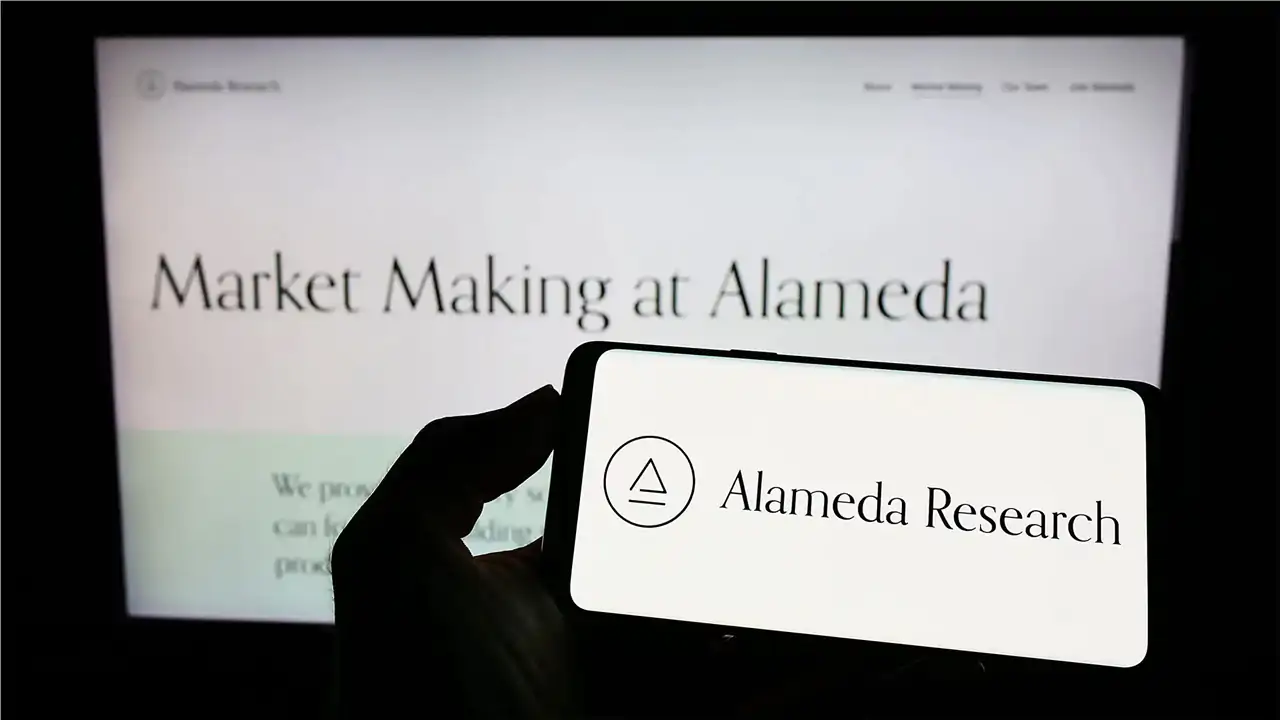Alameda Research is a little-scrutinized power player in virtual currencies. As its influence grows, so do concerns over a potential market advantage
Annie Massa
Anna Irrera
Hannah Miller
To the uninitiated, Alameda Research sounds more like a Silicon Valley robotics lab than a crypto trading powerhouse.
Even as its billionaire co-founder Sam Bankman-Fried graces the pages of Vogue and Vanity Fair, and sister company FTX spends millions stamping its logo on stadiums and sports gear, the Bahamas-based quant shop is barely known outside of crypto circles.
That’s just the way Alameda likes it -- in fact, its name was specifically chosen to not draw attention.
In recent months, though, it’s gotten harder for Alameda to fly under the radar.
After starting off as a lucrative arbitrage trading firm, Alameda has transformed itself into one of the largest market makers of digital tokens globally. With a staff of only 30, it generated about $1 billion in profit last year alone, putting it on par with Wall Street mainstays, including some of the biggest traders of US stocks. And it has quickly become a force in everything from decentralized finance to venture investing and even distressed lending
As its influence spreads, so have concerns over potential conflicts of interest -- particularly its relationship with , the world’s second-largest cryptocurrency exchange. At a minimum, some say Alameda is able to benefit from a dearth of regulation, a claim that carries even more weight as Bankman-Fried strives to use his position and influence in the crypto community to shape US oversight of the sector.
FTX and Alameda “have been able to benefit from a regulatory gap that has allowed them to trade and profit from cryptocurrencies without having to follow the same rules as traditional financial institutions,” said Cory Klippsten, chief executive officer of startup Swan Bitcoin.
Amplifying these concerns, the collapse in crypto has revealed a tangle of interconnections between Alameda, FTX and the broader virtual-currency markets -- and a larger role behind the scenes for both firms than many had previously known.
In interviews, Bankman-Fried, 30, and Alameda CEO Caroline Ellison, 27, who took over last year when Bankman-Fried shifted to FTX full-time, say that the companies have strict barriers in place when it comes to information and resource sharing.
“Alameda is a wholly separate entity,” said Bankman-Fried, who’s estimated to own more than 50% of FTX, based on the firm’s fundraising history, and almost all of Alameda. It sends orders and accesses customer information the same way other users do, he added.
To be clear, the concerns are to this point largely theoretical -- no one claims to have evidence of preferential treatment. But market participants, many of whom would only speak on background given Alameda and FTX’s outsized roles in the industry, are nonetheless concerned about the potential for unfair advantage.
Prop Shop
Questions persist, in part, because the lives of the firms’ leadership and employees are so deeply entwined.
Bankman-Fried and Ellison, along with roughly eight other colleagues, until recently shared an apartment not far from FTX and Alameda’s offices. , who co-founded Alameda with Bankman-Fried, is the chief technology officer at FTX, and many of their co-workers live and socialize together in the Bahamas, where FTX is also headquartered.
“We’re arm’s length and don’t get any different treatment from other market makers,” said Ellison, who’s leading Alameda following the departure of co-CEO Sam Trabucco last month.
Ellison, much like the company she runs, isn’t one for the limelight. The executive, who tends to avoid interviews and posting on social media, joined Alameda in 2018, a few months after its launch. Initially, it was little more than a proprietary trading shop made up of a handful of young alums from quantitative firms including Jane Street and Susquehanna.
One of its initial strategies sought to capitalize off of price differences between cryptocurrencies in the US and Japan, where Bitcoin traded at a roughly 10% premium. At the peak, Alameda was sending $15 million between the two countries daily and generating $1.5 million in profit. Within a few weeks the price gap disappeared, but not before the company had earned about $20 million.
Read more: A 30-Year-Old Crypto Billionaire Wants to Give His Fortune Away
As crypto expanded in popularity and attracted more professional investors, the arbitrage opportunities became less lucrative. Partly in response, and partly as a way to reinvest their winnings, Bankman-Fried and company launched FTX, and Alameda began shifting its focus from arbitrage to market making.
Nascent Regulation
Whereas exchanges like FTX make money via transaction fees and the interest on loans to traders, Alameda generates income from buying and selling tokens -- profiting from the spread between what it pays and what it offers.
In traditional financial markets -- on stock exchanges, for instance -- the two lines of business are usually unaffiliated, helping ensure competition among stakeholders and lower prices for customers.
In crypto, regulation is less defined. Disclosure rules or even industry norms that discourage close ties between a market center and a trading operation have yet to develop. In the case of FTX and Alameda, it’s as if the New York Stock Exchange and market-making giant Citadel Securities shared the same owner.
Having exchanges and market makers with close ties and financial interests is “not conducive to being a fair marketplace,” said Larry Tabb, head of market-structure research at Bloomberg Intelligence, speaking broadly. There are “reasons to split up the functions, to make sure everyone is on the up and up. When you consolidate and decompress divisions, you get inherent conflicts.”
More on Sam Bankman-Fried’s Crypto Realm:
- Sam Bankman-Fried Expands Crypto Empire During $2 Trillion Rout
- Crypto Billionaires Tempt Antitrust Fate: Bloomberg Crypto
- Sam Bankman-Fried Says His Crypto Bailouts Had ‘Mixed Results’
- Bankman-Fried’s Crypto Firm Alameda Is All Things to Voyager
Bankman-Fried says that while Alameda once was the largest trader on FTX -- a situation born out of the exchange’s limited access to liquidity in its early years -- its role has lessened over time, to the point that it’s no longer the platform’s biggest market maker.
The full scope of Alameda’s current market-making activity on FTX is difficult to gauge. Trading happening on crypto exchanges is not typically recorded on blockchains, the public ledgers that track transactions of cryptocurrencies. Instead, buying and selling on centralized digital asset venues is normally recorded on the order books of exchanges. While bids, offers and volume data is public, information on who’s behind the trades is not, making it hard to determine which parties are the most active.
Public blockchains do, however, record flows of cryptocurrencies into wallets that analytics firms can identify as belonging to exchanges. So data gathered from analyzing on-chain activity -- transactions recorded on blockchains -- can help provide a glimpse into the flows of assets between FTX and Alameda.
By this limited measure of activity, Alameda remains a large player on FTX. Between June 1st and July 22nd, Alameda's known wallets were the largest stablecoin depositors and sources of liquidity to all of FTX's known wallet addresses, according to data provided to Bloomberg by analytics firm AnChain.ai (stablecoins, typically pegged 1-for-1 with a dollar, are the most actively traded virtual tokens as they function as a bridge between hard currencies and crypto assets.)
Over the period analyzed, Alameda accounted for more than 10% of all transfers involving Tether, the most widely held stablecoin globally, and 30% of all USD Coin transfers, the second most widely held, the data show.
Trades via FTX’s order book all go through the same process for matching with counterparties, and Alameda operates under the same terms and conditions as other comparable users, an FTX spokesperson said in response to questions, noting that Alameda has been one of the larger liquidity providers for stablecoins on all platforms for many years.
For a QuickTake explainer on stablecoins, click here
More broadly, FTX appears to be an exchange of choice for Alameda. About 50% of Alameda’s deposit and withdrawal volume since early 2018 has flown through FTX, according to data on the platform of Arkham, a crypto intelligence firm that builds software to decloak anonymous transactions.
Similarly, 22% of on-chain deposits and withdrawals to FTX digital wallets interact with wallets belonging to Alameda, the data show. In contrast, only 4% of the on-chain volume associated with deposit addresses and digital wallets on Binance, the biggest crypto exchange, interact with Alameda.
A spokesperson for Alameda declined to comment on the data.
The figures don’t show whether Alameda is the largest market maker on FTX, as the exchange's full order book data with identifiers would be required to make that determination. But they do show that a significant amount of digital assets continue to flow between FTX and Alameda.
Based on Alameda’s own data, it has averaged about 2.15% of overall two-sided transaction volume on FTX this year, the firm said.
“We definitely have a Chinese wall in terms of information sharing to ensure that no one in Alameda would get customer information from FTX or anything like that, or any sort of special treatment from FTX,” Ellison said. “It’s very important for FTX to be perceived as a fair, neutral marketplace where everyone gets an equal shot.”
Alameda-FTX Connection
About half of Alameda's deposit and withdrawal volume since early 2018 has flown through FTX, based on ARKHAM platform data through Aug. 31
Source: Arkham
The concern isn’t necessarily over Alameda’s market share on FTX, but also the fact that there are fewer regulatory guardrails between the two to foster transparency and prevent potential conflicts of interest compared to traditional finance.
Most crypto platforms such as FTX aren’t registered with the US Securities and Exchange Commission. Registering with the SEC comes with additional oversight from the watchdog, along with disclosures about finances, ownership, users and protocols.
“The big difference between crypto and equities is that in equities, you have policies, procedures, and a regulator that will investigate,” said David Weisberger, co-founder of crypto trading platform CoinRoutes. In crypto, “there is a clear case for having a regulator to prove that potential conflicts aren’t happening, and to stop them from happening.”
SEC Chair Gary Gensler in late July said that the agency is considering whether to address potential conflicts of interest when crypto platforms also serve as market-makers, after previously raising concerns that some platforms are shirking rules and may be betting against their own customers. He didn’t single out any firms by name.
Bankman-Fried notes that FTX’s global reach means that it is among the most regulated exchanges in the world. In addition to being registered with multiple US federal agencies, it’s authorized by financial authorities in the European Union, Japan, Australia, Switzerland, Dubai and the Bahamas, among others
“Crypto has been substantially more lightly regulated with much less oversight than traditional finance, but I don't think it's that's actually true of FTX,” he said.
Market watchers are quick to point out that being under the supervision of authorities from the Bahamas is different than falling under the purview of the SEC.
Read more: SEC’s Gensler Says Crypto Exchanges Trading Against Clients
Alameda, in fact, was originally based in Berkeley, California, before uprooting for Hong Kong and ultimately the more crypto-friendly Caribbean.
The SEC’s regulatory ambitions have coincided with Bankman-Fried’s recent efforts to be at the vanguard of establishing federal oversight for the industry, pushing what governance should look like and who should be in charge.
He’s traveled frequently to Washington, spent millions on lobbyists, and has testified before Congress as an advocate for the industry, arguing for a bigger role for the U.S. Commodity Futures Trading Commission, widely viewed as friendlier to the industry than the SEC.
FTX US, the American affiliate of FTX, is actively engaged in talks with the SEC about registering with the regulator once a framework for digital-asset exchanges is established, the spokesperson for FTX said.
DeFi, Venture
Any perceived lack of oversight hasn’t stopped traders from flocking to FTX. The company reported $719 billion in spot trading volume in 2021, a 2,400% increase from the previous year.
Meanwhile Alameda has branched further out through the crypto ecosystem.
Alameda said in February that it would borrow up to $750 million from TrueFi, a crypto lending platform that allows investors to earn a return in exchange for staking their tokens to borrowers. The funds were to finance some of its $5 billion in daily trading activity, "a double-digit percentage" of which takes place on DeFi applications rather than centralized exchanges, Alameda said at the time.
On the venture front, the firm has backed some of the biggest up and comers in crypto, including Anchorage Digital, a federally chartered crypto bank, and Magic Eden, the largest nonfungible token marketplace on the Solana blockchain.
Combined, Alameda, FTX and Bankman-Fried have made 117 investments since 2020, according to data provider CBInsights.
Alameda’s venture operations were recently shifted to FTX’s startup investment arm FTX Ventures, Bloomberg reported last month.
As the rout in crypto worsened earlier this year, the bankruptcy filings of firms including Voyager Digital and Celsius Network shed further light on Alameda’s vast industry influence.
Two most interesting things in the Voyager bankruptcy petition:
(1) Voyager's second largest exposure is to Alameda Research. So there's some recycled capital. Voyager loans Alameda $377M, & Alameda reloans Voyager $75M. Plus Alameda is Voyager's largest shareholder (9.5%). 1/
— Adam Levitin (@AdamLevitin) July 6, 2022
Alameda extended a $485 million credit line to Voyager Digital just days before the broker sought bankruptcy protection (and before it could tap the full loan), a deal Bankman-Fried was actively involved in. It also owed Voyager Digital at the time, while simultaneously being one of its biggest shareholders. Alameda is also listed as a creditor for Celsius.
Alameda and FTX jointly offered to buy much of Voyager Digital’s assets, an offer the bankrupt company referred to as a “low-ball bid” in a court filing.
“Alameda is probably the largest discretionary book of capital in crypto,” said Kyle Samani, managing partner at crypto venture capital firm Multicoin Capital, which invested in FTX. “They had a lot of cash, and they are now in a position to go shopping for assets at very, very good prices.”
— With assistance by Olga Kharif



 BlocksInform
BlocksInform










